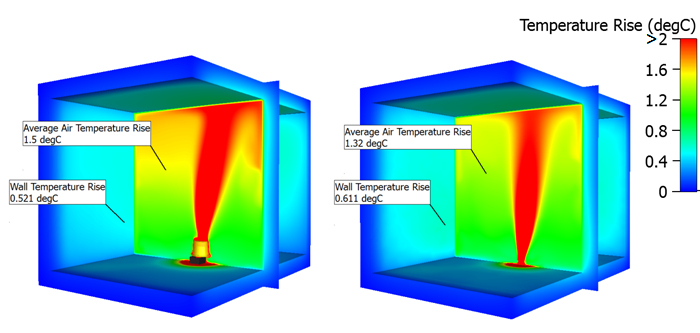Heat Your Home Office for 8p (10cents) a Day. Part 2 – Thermal Interception
We often do things that we intuitively feel are beneficial, often without realising just why. One of the beauties of simulation is its ability to provide insight into a physical phenomena or design. Sometimes described as a computational experiment, simulation can do more, and more easily, in terms of instrumenting a system. I’ve applied this advantage to help describe why putting a couple of flowerpots on top of some tealights is a good thing for room heating.
‘Good thing’ compared to what? Well, surely compared to not putting the flowerpots on top of the candles. Both approaches will supply the same amount of heat to a room, let’s first verify the difference in the response of the room to these two energy-equal forms of tealight heating.
The room air temperature when using the flowerpots is ~14% higher than when not using them. Not a massive difference but appreciable. The (maximum) wall temperature on the other hand is about 17% higher when not using the flowerpots. To explain these two opposing trends let’s look at how the heat generated by the candles is dispersed in the room.
CFD simulation produces a wealth of information, for every object in the model it is possible to note not only their temperatures, but also the heat that flows through them, especially the different types of heat transfer. The 140W that is supplied to the room (not created, but converted from the burning wax) has to pass from the candle flames, through to the room space, through the walls, and out to the outside. This power must be preserved, rather conserved; power into the room must = power out of the room. Examining the simulation results to track the two main ways in which heat flows from the candle source, by convection (moving air) and radiation (surface to surface infrared electromagnetic transfer), to the walls yields the following so called ‘heat flux budgets’:
Qconv is the amount of heat convected away from the heater. Qrad is the amount of heat radiated away from the heater. Both measured in Watts.
The candle flames burn hot, at about 1400 degC. As radiative transfer is related to a T^4 difference (between source and other surface) this results in a much higher proportion of the total heat supplied getting to the walls directly using that mode of heat transfer (43%). Put a couple of flowerpots over those flames and much of that radiative heat is intercepted, heats up the pots, giving the air time to convect that heat away to the room air, accounting for 80% of the total power supplied. (Sorry, I’m interchanging ‘heat’ and ‘power’ a bit too readily, they are intended to mean the same thing in this case). Sure, some heat then goes on to radiate from the pots to the walls, but much less as the temperature difference between the pots and walls is much less that between the flame and the walls. In fact maybe that’s the real beauty of using the 2nd bigger pot, it provides a secondary radiative interception, catching more heat to then be given back to the air.
So, more heat goes to the air, increasing the room air temperature. Less heat is ‘lost’ in radiating to the very large surface area (and very cold) walls where that paltry amount of heat does very little to make an occupant feel more comfortable (well, it does much less than an increase in the air temperature).
However, at this stage I’ll come clean and admit to all the simulations done so far being… what’s the word?…. ‘untrue’.
All the above was simulated with a ‘steady state’ assumption. That is that the whole system has been assumed to be up and running for long enough that it has settled down to a state where temperatures do not change any more in time. In reality these 4 tealights only last about 4 hours.
Next up I’ll be simulating the transient response of the room to these two heating methods, see what both are like after 4 hours. Who knows, maybe the flowerpot method will prove to be even more beneficial compared to bare candles under those time constraints? Both time, and simulation, will tell.
All the Blogs in this series:
- Part 1 – Really?
- Part 2 – Thermal Interception
- Part 3 – It Takes Time
- Part 3a – Was Dave Right?
- Part 4 – Comfort Temperature
- Part 5 – Putting it All Together

